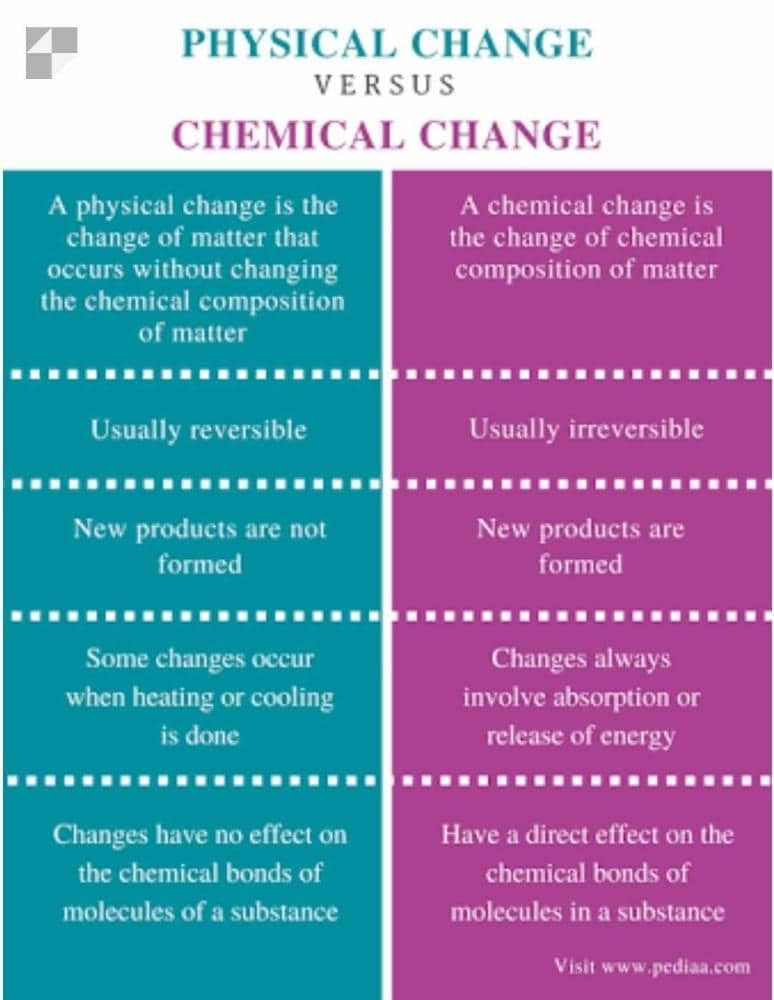UPSC Exam > UPSC Questions > What is physical change and chemical change?
Start Learning for Free
What is physical change and chemical change?
Most Upvoted Answer
What is physical change and chemical change?

Community Answer
What is physical change and chemical change?
Physical Change:
A physical change is a type of change in which the form of matter is altered, but not its chemical composition. This means that the substance involved in the change remains the same on a molecular level. Examples of physical changes include changes in state (solid to liquid to gas), changes in shape or size, and dissolving.
Key points:
- No new substance is formed during a physical change.
- The change is usually reversible.
- Physical properties such as color, shape, size, and state may be altered.
Chemical Change:
A chemical change, on the other hand, involves a transformation of one or more substances into different substances with new properties. This type of change is often irreversible and results in the formation of new chemical bonds. Common examples of chemical changes include rusting of iron, burning of wood, and baking a cake.
Key points:
- New substances are formed during a chemical change.
- The change is usually irreversible.
- Chemical properties such as reactivity, flammability, and toxicity may be altered.
In summary, physical changes involve alterations in the form of matter without changing its chemical composition, whereas chemical changes result in the formation of new substances with different properties. Understanding the differences between these two types of changes is crucial in various fields such as chemistry, physics, and biology.
A physical change is a type of change in which the form of matter is altered, but not its chemical composition. This means that the substance involved in the change remains the same on a molecular level. Examples of physical changes include changes in state (solid to liquid to gas), changes in shape or size, and dissolving.
Key points:
- No new substance is formed during a physical change.
- The change is usually reversible.
- Physical properties such as color, shape, size, and state may be altered.
Chemical Change:
A chemical change, on the other hand, involves a transformation of one or more substances into different substances with new properties. This type of change is often irreversible and results in the formation of new chemical bonds. Common examples of chemical changes include rusting of iron, burning of wood, and baking a cake.
Key points:
- New substances are formed during a chemical change.
- The change is usually irreversible.
- Chemical properties such as reactivity, flammability, and toxicity may be altered.
In summary, physical changes involve alterations in the form of matter without changing its chemical composition, whereas chemical changes result in the formation of new substances with different properties. Understanding the differences between these two types of changes is crucial in various fields such as chemistry, physics, and biology.
Attention UPSC Students!
To make sure you are not studying endlessly, EduRev has designed UPSC study material, with Structured Courses, Videos, & Test Series. Plus get personalized analysis, doubt solving and improvement plans to achieve a great score in UPSC.

|
Explore Courses for UPSC exam
|

|
Similar UPSC Doubts
What is physical change and chemical change?
Question Description
What is physical change and chemical change? for UPSC 2024 is part of UPSC preparation. The Question and answers have been prepared according to the UPSC exam syllabus. Information about What is physical change and chemical change? covers all topics & solutions for UPSC 2024 Exam. Find important definitions, questions, meanings, examples, exercises and tests below for What is physical change and chemical change?.
What is physical change and chemical change? for UPSC 2024 is part of UPSC preparation. The Question and answers have been prepared according to the UPSC exam syllabus. Information about What is physical change and chemical change? covers all topics & solutions for UPSC 2024 Exam. Find important definitions, questions, meanings, examples, exercises and tests below for What is physical change and chemical change?.
Solutions for What is physical change and chemical change? in English & in Hindi are available as part of our courses for UPSC.
Download more important topics, notes, lectures and mock test series for UPSC Exam by signing up for free.
Here you can find the meaning of What is physical change and chemical change? defined & explained in the simplest way possible. Besides giving the explanation of
What is physical change and chemical change?, a detailed solution for What is physical change and chemical change? has been provided alongside types of What is physical change and chemical change? theory, EduRev gives you an
ample number of questions to practice What is physical change and chemical change? tests, examples and also practice UPSC tests.

|
Explore Courses for UPSC exam
|

|
Suggested Free Tests
Signup for Free!
Signup to see your scores go up within 7 days! Learn & Practice with 1000+ FREE Notes, Videos & Tests.

























